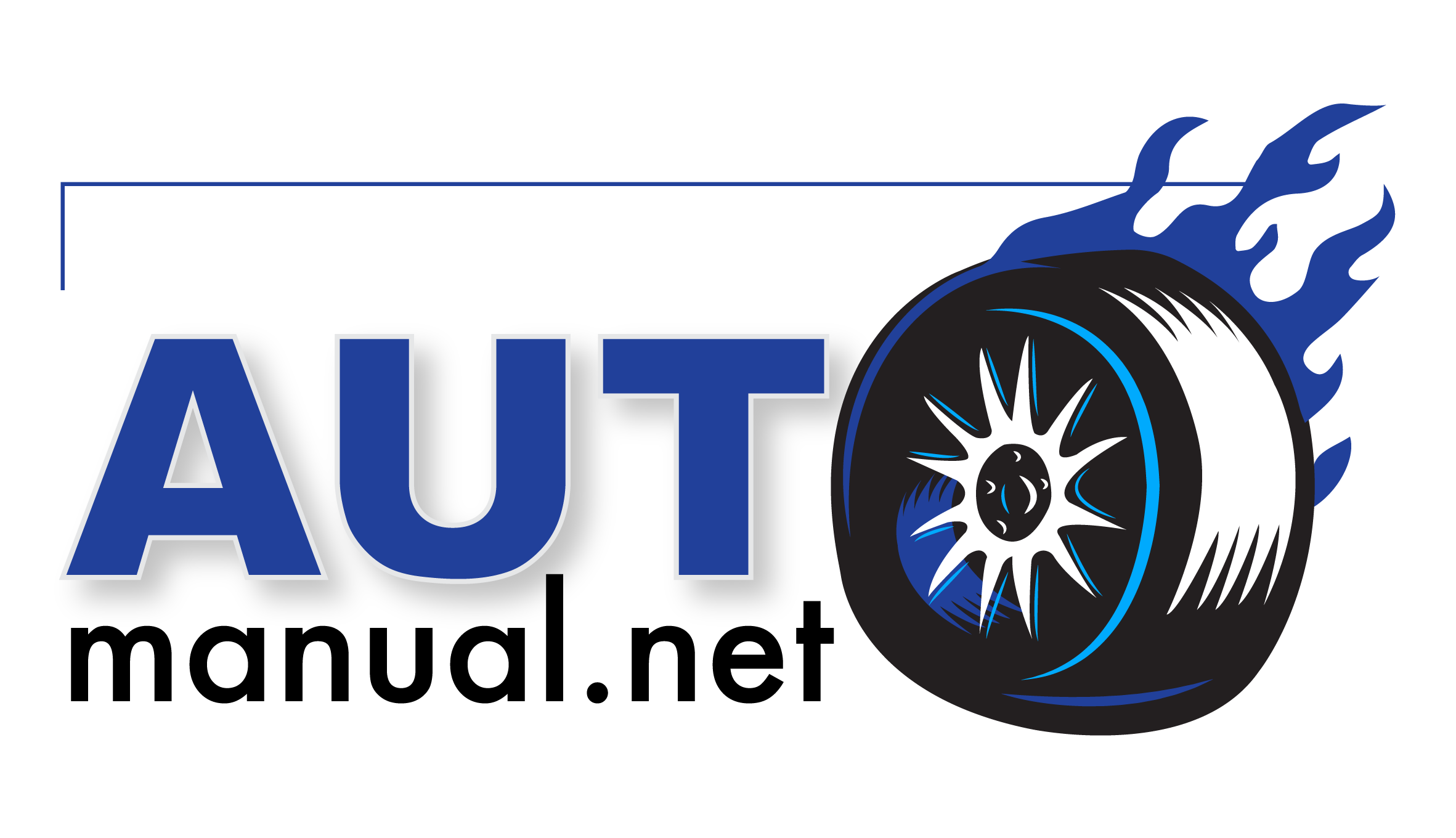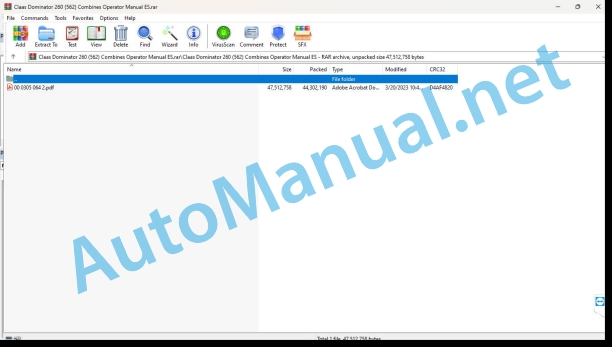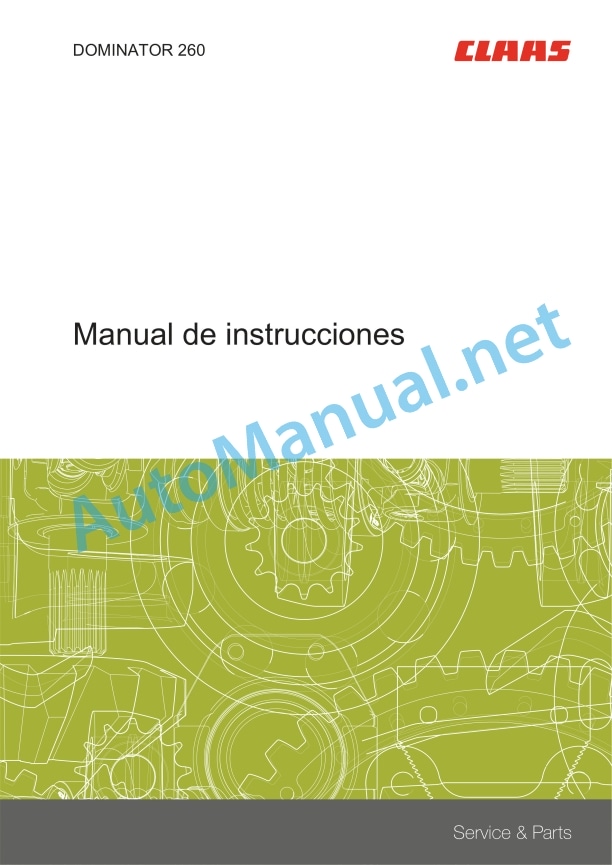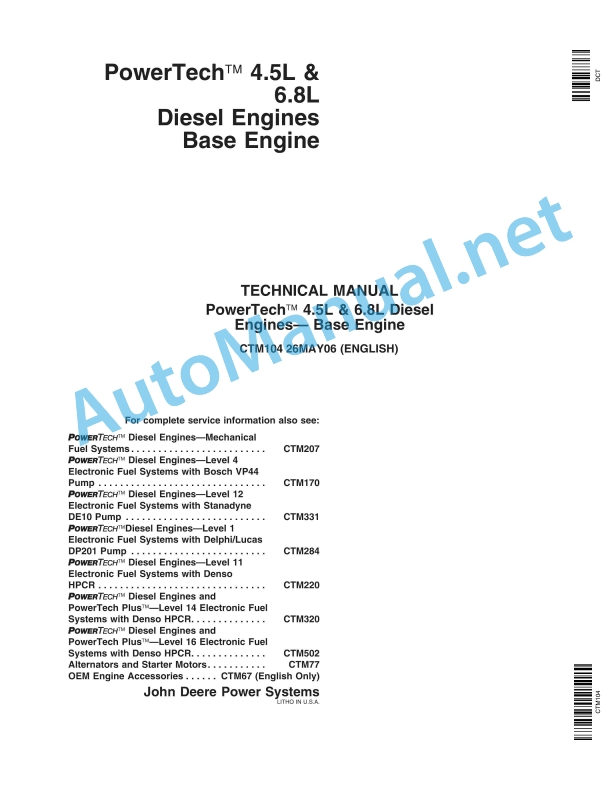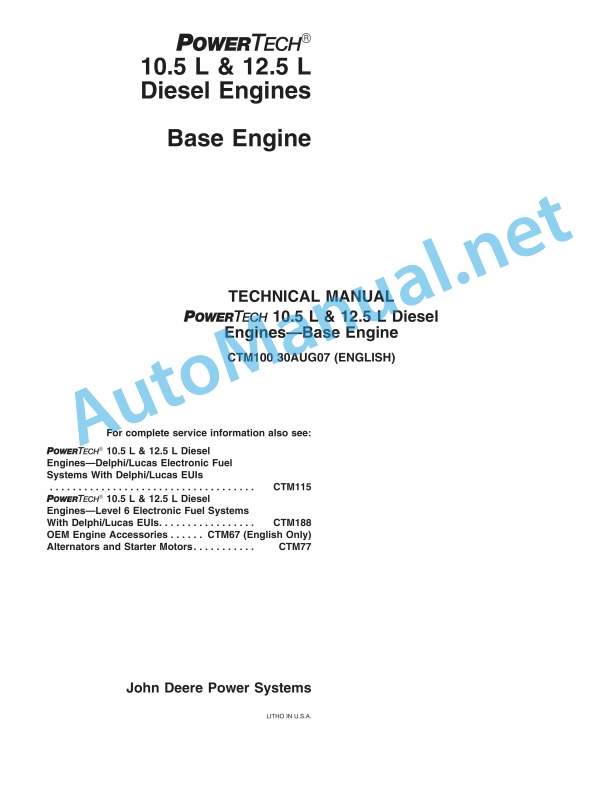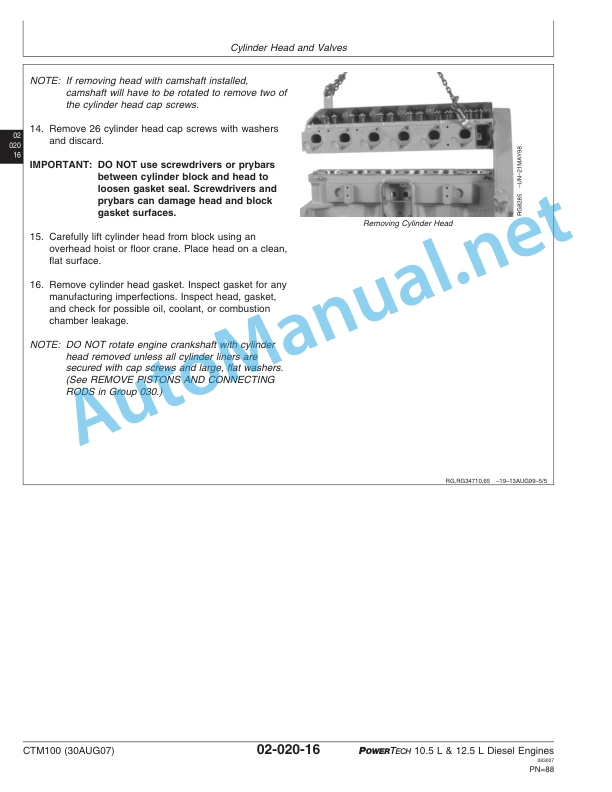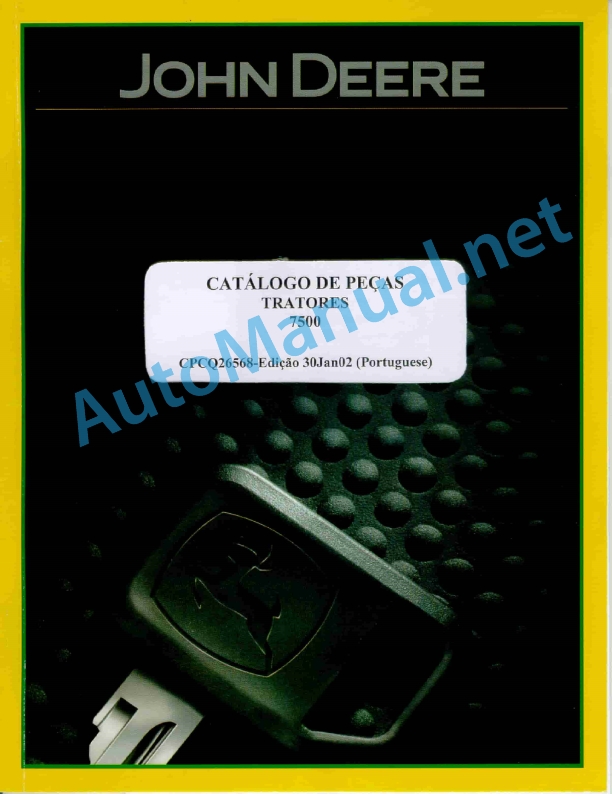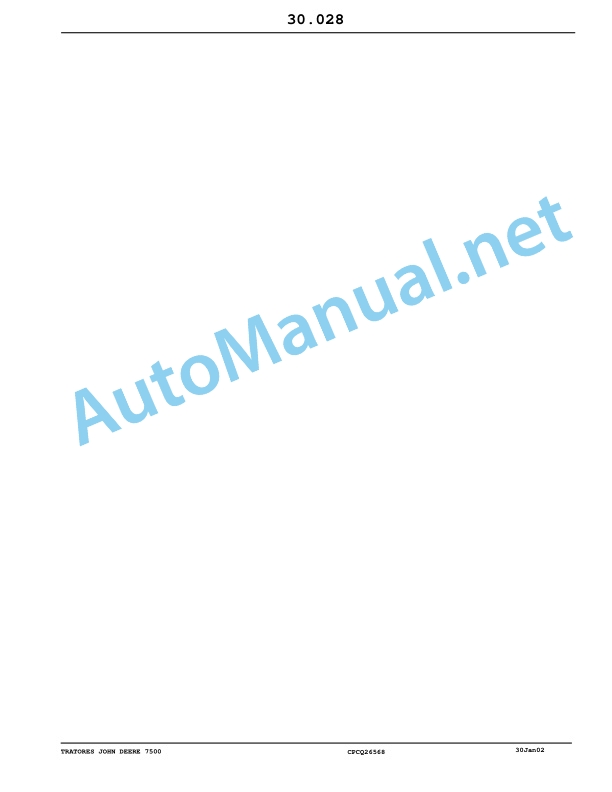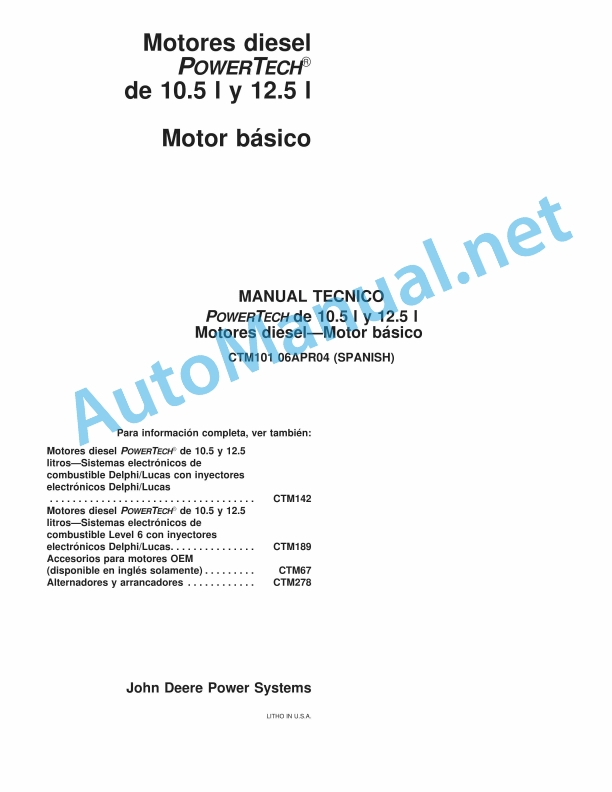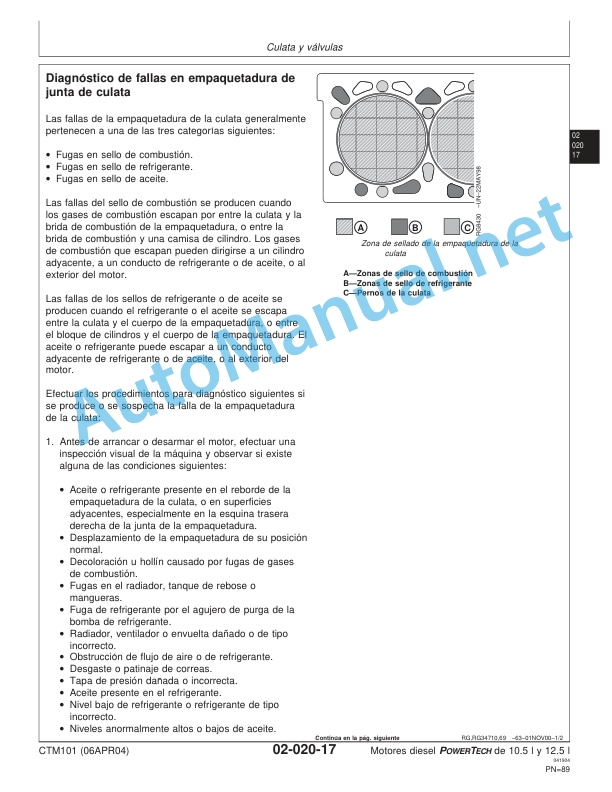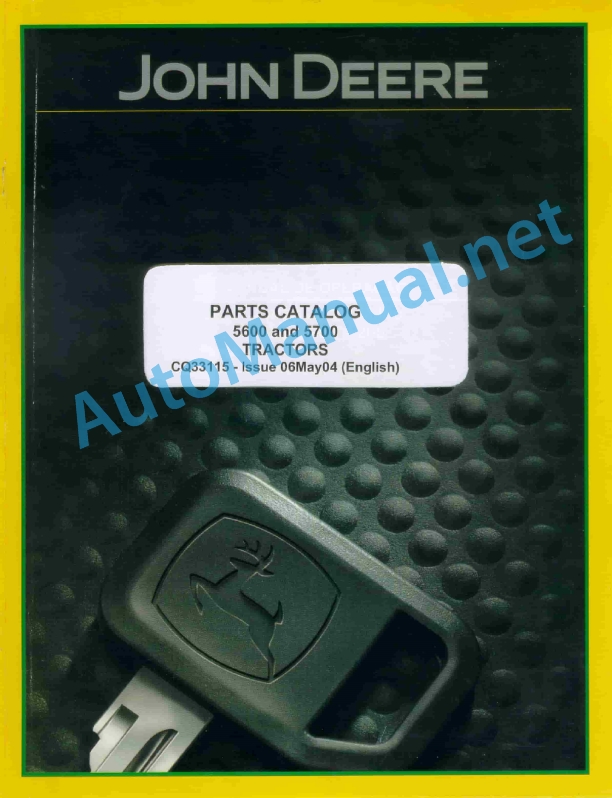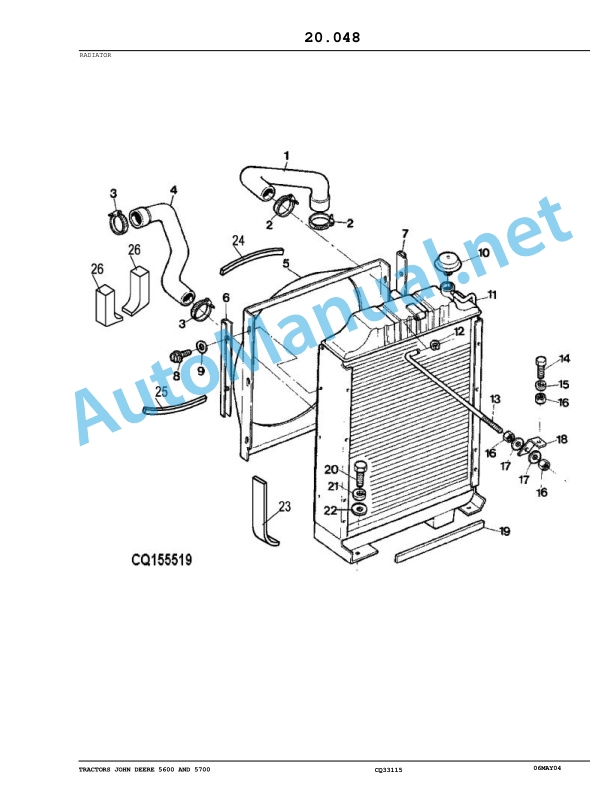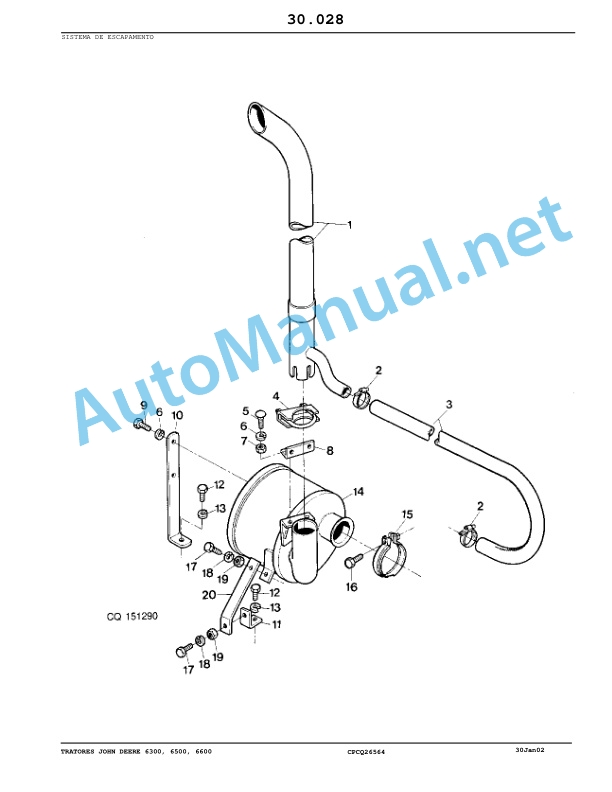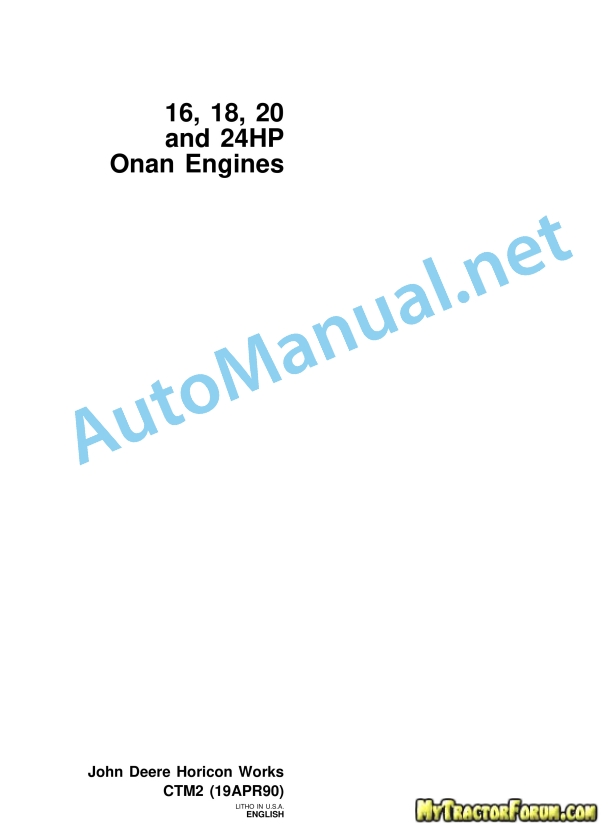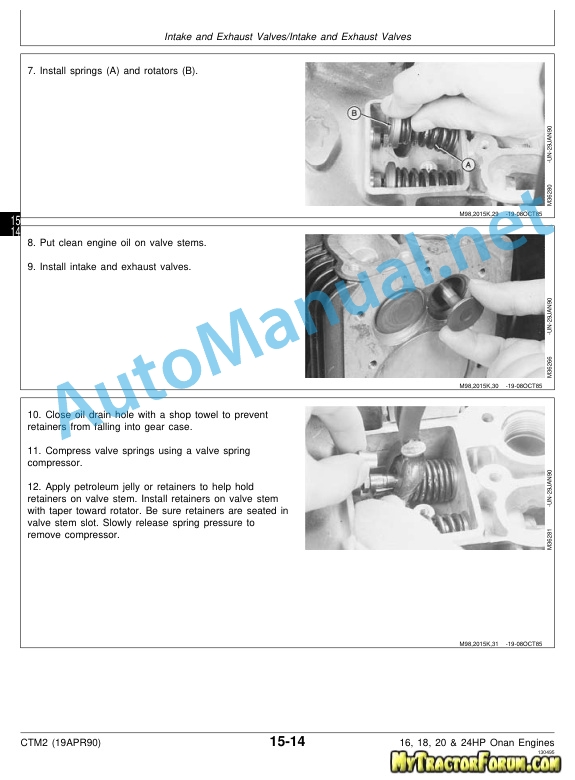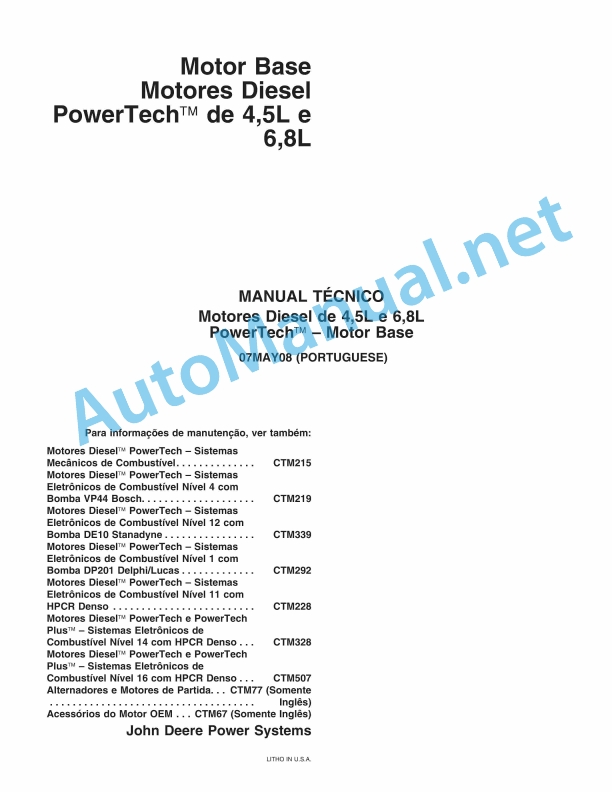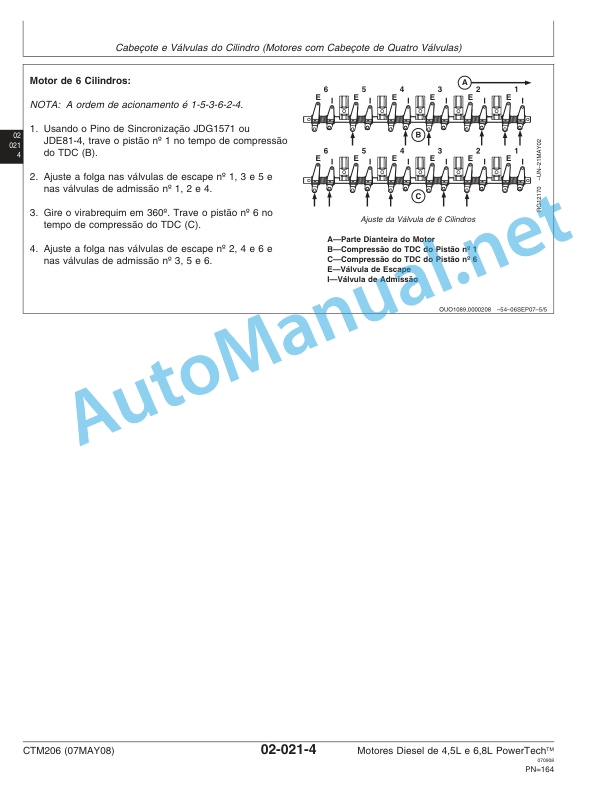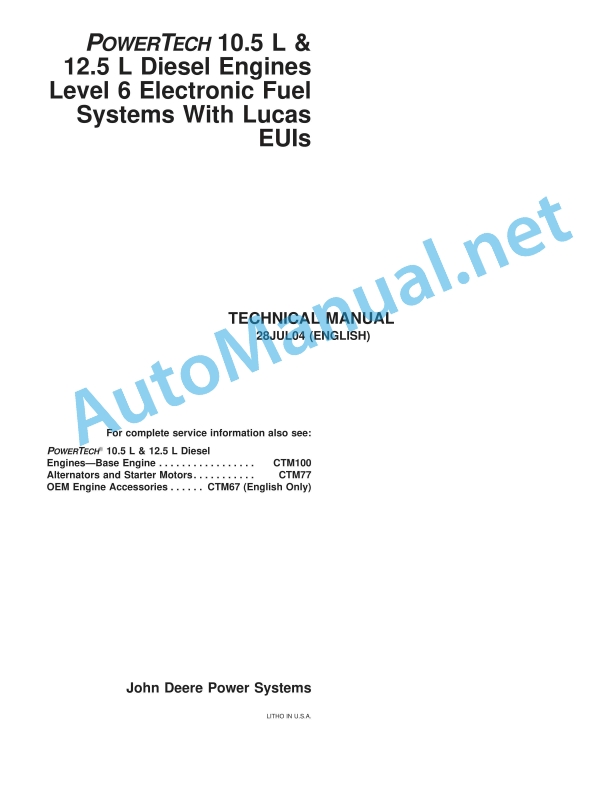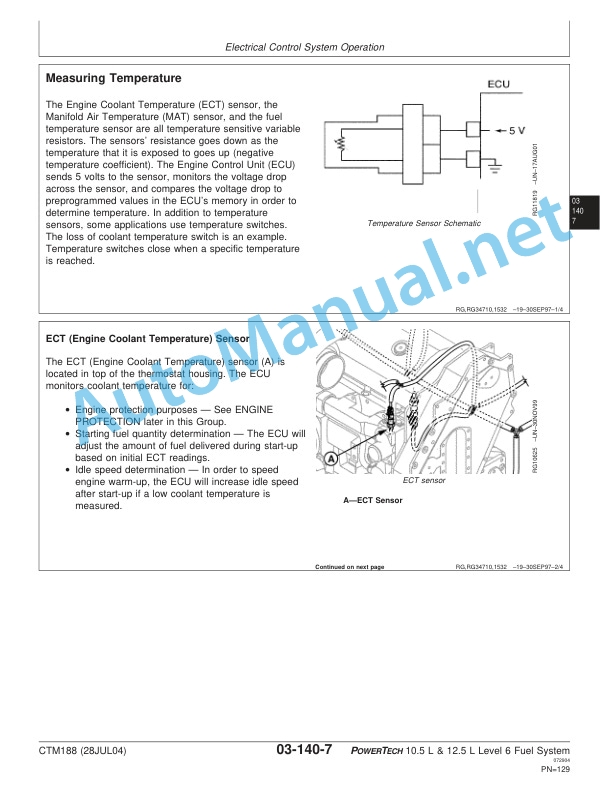Claas Dominator 260 (562) Combines Operator Manual ES
$50.00
- Model: Dominator 260 (562) Combines
- Type Of Manual: Operator Manual
- Language: ES
- Format: PDF(s)
- Size: 42.3 MB
File List:
00 0305 064 2.pdf
00 0305 064 2.pdf:
DOMINATOR 260
1. Introduction
1.1 Information regarding the instruction manual
1.1.1 Validity of the manual
1.1.2 Information about this instruction manual
1.1.3 Symbols and indications
1.1.4 Optional equipment
1.1.5 Qualified specialized workshop
1.1.6 Maintenance instructions
1.1.7 Information regarding warranty
1.1.8 Spare parts and technical questions
1.2 Proper application of the machine
1.2.1 Proper machine application
1.2.2 Logically foreseeable misuse
2 Security
2.1 Recognize warning signs
2.1.1 Danger symbols
2.1.2 Keyword
2.2 Safety instructions
2.2.1 Meaning of the instruction manual
2.2.2 Observe graphic danger symbols and alarm indications
2.2.3 Requirements for all people working with the machine
2.2.4 Children in danger
2.2.5 Danger zones
2.2.6 Position yourself between the machine and the head
2.2.7 Accompanying instructors during work
2.2.8 Attach the machine to a header or transport trailer
2.2.9 Risk of injury due to rotating shafts
2.2.10 Construction modifications
2.2.11 Optional equipment and spare parts
2.2.12 Control of the machine in operation
2.2.13 Use only after correct commissioning
2.2.14 Technical status
2.2.15 Danger due to machine breakdowns
2.2.16 Comply with technical limit values
2.2.17 Danger from machine parts during coasting
2.2.18 Maintain functional protection devices
2.2.19 Personal protective equipment
2.2.20 Wear appropriate clothing
2.2.21 Remove dirt and loose objects
2.2.22 Dangers when driving on the road and in the countryside
2.2.23 Park the machine safely
2.2.24 Unsuitable consumables
2.2.25 Safe handling of consumables and auxiliary materials
2.2.26 Fuel is harmful to health
2.2.27 Cooling agents are harmful to health
2.2.28 Environmental protection and waste disposal
2.2.29 Fire prevention
2.2.30 Electric shock with danger to life due to unprotected cables
2.2.31 Behavior in the case of voltage discharge through unprotected cables and lightning strikes
2.2.32 Electrical shock from electrical equipment
2.2.33 Noise can have negative consequences for health
2.2.34 Vibrations can cause health injuries
2.2.35 Liquids under pressure
2.2.36 Pressurized air
2.2.37 Toxic exhaust gases
2.2.38 Hot surfaces
2.2.39 Getting on and off safely
2.2.40 Work only on the stopped machine
2.2.41 Maintenance work and repair work
2.2.42 Machine parts and lifted loads
2.2.43 Danger from welding work
2.2.44 Check and charge the battery
2.3 Safety signage
2.3.1 Structure of graphic hazard symbols
2.3.2 Diesel engine graphic danger symbols
2.3.3 Graphic danger symbols of the hydraulic installation
2.3.4 Cab hazard graphic symbols
2.3.5 Graphic danger symbols of the power supply unit
2.3.6 Graphic danger symbols for threshing equipment
2.3.7 Graphic cleaning danger symbols
2.3.8 Graphic danger symbols for crop discharge and straw discharge
2.3.9 Graphic hazard symbols for grain harvesting
2.3.10 Graphic danger symbols on mounting parts and machine body
3 Machine Description
3.1 Summary and operation
3.1.1 Overview of the machine front and left
3.1.2 Summary of the machine behind and right
3.1.3 Machine operating mode
3.1.4 Perkins 1106D-E70TA Diesel Engine Summary
3.1.5 Summary of concaves
3.1.6 Closing system
Standard locking system
3.2 Optional equipment
3.2.1 4-TRAC*
3.3 Identification plates and identification numbers
3.3.1 Identification plate on Perkins 1106D-E70TA diesel engine
3.3.2 Machine identification plate
3.3.3 Drive axle identification plate
3.3.4 Steering axle identification plate
3.3.5 Straw chopper identification plate
3.4 Machine information
3.4.1 Chassis adhesive
3.4.2 Grain collection stickers
3.4.3 Adhesives on assembly parts and machine body
3.4.4 Hydraulic installation adhesives
4 Control and display instruments
4.1 Cabin and driving position
4.1.1 Driver’s platform
4.1.2 Control desk
4.1.3 Cabin roof
4.1.4 Advance lighting and work lights
4.1.5 Operator seat
4.1.6 Steering column
4.1.7 Column B
4.1.8 Ignition contact
4.1.9 Multifunctional control
4.1.10 Air conditioning equipment
4.1.11 Camera systems monitor*
4.1.12 Windshield wiper detergent tank
4.2 On-board computer and display devices
4.2.1 CEBIS general instructions
4.2.2 Preview Screen Summary
4.2.3 Harvest Screen Summary
4.2.4
4.2.5 Take into account the messages in CEBIS
Take into account the type of messages
Take into account the structure of the error code information
Turn off error code information
View alarm history
View active alarms
4.2.6 Indicator cell symbols
5 Technical data
5.1 DOMINATOR 260
5.1.1 Perkins 1106 D-E70TA
5.1.2 Sound pressure level and vibrations
5.1.3 Machine dimensions
5.1.4 Measurements of the grain tank discharge tube in working position
5.1.5 Turning diameter
Measurement conditions
5.1.6 Chassis
5.1.7 Drive axle track width
Tire pressure
5.1.8 Steering axle track width
Tire pressure
5.1.9 Brake
5.1.10 Perkins 1106 D-E70TA diesel engine battery
5.1.11 Width of the shelling cylinder
5.1.12 Threshing system
5.1.13 Separation
5.1.14 Cleaning
5.1.15 Unloading of the harvest and unloading of the straw
5.1.16 Grain tank volume
5.1.17 Grain tank discharge performance
5.1.18 Weights
5.2 Inputs
5.2.1 Lubricants
5.2.2 Coolant liquid
5.2.3 Hydraulic oil
6 Preparation of the machine
6.1 Turn off the machine and secure it
6.1.1 Turn off the machine and secure it
6.1.2 Secure the machine so that it cannot roll
6.2 Access jobs and maintenance positions
6.2.1 Swing the front ladder up and down
Swing ladder up to transport position
Swing the front ladder down into the access position
6.2.2 Use the rear ladder
Place the rear ladder in the transport position
Place the rear ladder in the access position
Remove and install the rear ladder
6.2.3 Access the workplace
Access the workplace
6.2.4 Access maintenance stations
Access the maintenance station
Access the maintenance station
Access the maintenance station
Access the maintenance station
6.2.5 Access access areas
Access the access area
Access the access area
Access the access area
Access the access area
Access the access area
6.3 Prepare the machine for driving
6.3.1 Prepare for road traffic
6.3.2 Prepare the field trip
6.4 Adjust the machine to use for the job
6.4.1 Adjust the machine to cereal harvest
6.4.2 Adjust the machine to harvest corn
6.4.3 Adjust the machine to harvest rice
6.4.4 Adjust the rice harvesting machine to cereal harvesting
6.4.5 Table for threshing
6.4.6 Use machine with rice equipment
6.4.7 Screen table
6.4.8 Threshing segment
6.4.9 Clean the seed harvesting machine
6.5 Load the machine
6.5.1 Load and tie down the machine
6.5.2 Remove hitch rings
6.6 Head
6.6.1 Assembling and disassembling the head
6.6.2 Prepare the bolting
6.6.3 Assemble the ratchet
6.6.4 Check the head discharge pressure accumulator
6.7 Diesel engine
6.7.1 Select authorized fuel
6.7.2 Take fuel specification into account
6.7.3 Take fuel specification into account
6.7.4 Select authorized fuel
6.7.5 Use winter fuel at low temperatures
6.7.6 Refuel the machine
6.8 Chassis
6.8.1 Remove and install the wheels
Remove the wheels
Mount the wheels
6.8.2 Raise the machine on supports
6.8.3 Raise the machine on supports
6.8.4 Raise the machine to tilt the steering axle
6.8.5 Changing the steering axle from transport position to working position
6.8.6 Adjust the track width of the steering axle
Remove the adjustment bodies
6.9 Brake
6.9.1 Check the parking brake
6.9.2 Check the service brake
6.10 Towing device
6.10.1 Assemble the coupling mouth
6.10.2 Couple a trailer
6.10.3 Uncouple the trailer
6.11 Hydraulic system
6.11.1 Identify hydraulic oil
6.12 Electrical and electronic system
6.12.1 Install the air conditioning compressor fuse
6.12.2 Adjust the low beam
6.12.3 Change the road running light depending on the head
6.13 Cabin and driving position
6.13.1 Mount the approach mirror*
6.13.2 Adjust the approach mirror*
6.13.3 Control vision zones
6.13.4 Remove the transport lock from the cabin
6.13.5 Adjusting the control resistance of the drive lever
6.14 Power supply unit
6.14.1 Adjust the deflection pulley in the feed channel
6.14.2 Place the safety support in the feed channel
6.14.3 Remove the safety support in the feed channel
6.14.4 Check the anti-slip strips on the feed channel
6.15 Threshing mechanism
6.15.1 Open and close the stone collecting device
6.15.2 Dismantle and assemble the stone collection device
Dismantle the stone collection device
Assemble the stone collection device
6.15.3 Open and close the cylinder flap
6.15.4 Assembling and disassembling threshing segment
6.15.5 Check concave adjustment
Distance of the concave in the concave of wire N7/18* for wheat
Distance of the concave in the concave of rice teeth
Distance of the concave in the concave of round bars for corn
6.15.6 Assemble and dismantle the sheller cylinder cover
6.16 Separation
6.16.1 Dismantle and assemble the canvas bib
Remove the canvas bib
Assemble the canvas bib
6.16.2 Assemble and dismantle the side cockscombs
6.16.3 Assembling and disassembling central cockscombs
6.16.4 Assembling and disassembling central cockscombs behind
6.16.5 Assemble and disassemble cockscombs for rice
6.16.6 Assembling and disassembling CCM cockscombs
6.17 Cleaning
6.17.1 Dismantle the sieves
6.17.2 Assemble the screens
6.17.3 Check the basic regulation of the sieves
6.17.4 Cover and open the return*
6.18 Unloading of the harvest and unloading of the chaff
6.18.1 Adjust the speed of the straw chopper
6.18.2 Remove the bedknife
6.18.3 Adjusting the spreader plates of the spreader plate spreader
6.18.4 Mount the rubber corn cloth* on top of the straw chopper
6.19 Grain collection
6.19.1 Close the outlet hole in the grain tank
6.20 Assembly and body parts
6.20.1 Check the reversing horn
7 Management
7.1 Driving the machine
7.1.1 Take into account the instructions regarding road traffic.
7.1.2 Driving the machine
Drive the machine forward
Brake the machine
Stop the machine
Drive in reverse
7.1.3 Connecting the road traffic switch
Switch the road traffic switch to
Switch on the road traffic switch to
7.1.4 Maneuver the machine
7.1.5 Park the machine
7.2 Head
7.2.1 Connect the head to the control desk
7.2.2 Disconnect the head at the control desk
7.2.3 Disconnect the head on the multifunction controller
7.2.4 Invert the head
7.2.5 Adjust the reel speed
7.3 Diesel engine
7.3.1 Connect the diesel engine
Connect the diesel engine
With outside temperatures of 0° C to -10° C, allow the diesel engine and hydraulic system to preheat.
With outside temperatures of -10° C to -35° C, allow the diesel engine and hydraulic system to preheat.
7.3.2 Turn off the diesel engine
7.3.3 Adjust the diesel engine speed
7.3.4 Information regarding electronic engine management
7.4 Chassis
7.4.1 Shift into gear
7.4.2 Connect 4-TRAC*
7.4.3 Disconnect 4-TRAC*
.Running characteristics
7.4.5 Towing the machine from the danger zone
7.5 Brake
7.5.1 Braking the machine with the foot brake
7.5.2 Set the parking brake
7.5.3 Release the parking brake
7.6 Address
7.6.1 Take into account steering behavior
7.7 Electrical and electronic system
7.7.1 Learn the machine revolutions
7.7.2 Adjustment of slip limits
7.8 Cabin and driving position
7.8.1 Adjust the steering column
7.8.2 Putting on the seat belt
7.8.3 Turn on the air conditioning and adjust it
7.8.4 Adjust the air flow of the air conditioning system
7.8.5 Emergency exit
7.9 Guided by the ground
7.9.1 Record theoretical values for cutting height / support pressure
7.10 Threshing mechanism
7.10.1 Connect the threshing units
7.10.2 Disconnect the threshing mechanism
7.10.3 Adjust the speed of the shelling cylinder
7.10.4 Adjust the revolution range of the shelling cylinder
7.11 Cleaning
7.11.1 Manually adjust the sieves
7. Adjuhe fan speed
7.12 Unloading of the harvest and unloading of the chaff
7.12.1 Adjust the straw chopping length
7.12.2 Adjust the bedknife
7.12.3 Remove the bedknife
7.12.4 Adjusting the position of the spreader plate spreader
Adjust position
Adjust the straw guide plate
7.13 Grain collection
7.13.1 Open the grain tank cover
7.13.2 Adjust the grain tank discharge auger cover plates
7.13.3 Control return
7.13.4 Remove and insert the grain tank discharge tube
7.13.5 Connecting and disconnecting the grain tank discharge
8 Incident and solution
8.1 CEBIS on-board computer
8.1.1 Editing an active error code
8.1.2 Viewing warning history
View all warnings
View information
Meaning of codes and abbreviations
8.2 Diesel engine
8.2.1 Diesel engine incidents
8.2.2 Shut down the overheated diesel engine
8.2.3 Empty fuel
8.2.4 Summary of diesel engine malfunctions
8.3 Hydraulic installation
8.3.1 Manually lower the head
8.4 Electrical and electronic system
8.4.1 Open and close the base central electrical installation
8.4.2 Replacing incandescents
8.4.3 Externally start the diesel engine of the machine with 1 battery
8.4.4 Base central electrical system
8.4.5 Vehicle main fuse
8.5 Cabin and driving position
8.5.1 Summary of breakdowns in air conditioning equipment
8.6 Head
8.6.1 Summary of head faults
8.7 Power supply unit
8.7.1 Summary of feed channel faults
8.8 Threshing mechanism
8.8.1 Summary of breakdowns in threshing devices
8.8.2 Sheller cylinder
8.9 Separation
8.9.1 Summary of separation faults
8.10 Cleaning
8.10.1 Summary of cleaning faults
8.11 Unloading of the harvest and unloading of the chaff
8.11.1 Summary of breakdowns in harvest unloading and straw unloading
8.12 Grain collection
8.12.1 Summary of breakdowns in grain harvesting
8.12.2 Assemble the grain tank emptying safety screw
9 Maintenance
9.1 Summary of maintenance intervals
9.1.1 Before harvest
9.1.2 After the first 100 hours of service
9.1.3 After the first 500 hours of service
9.1.4 Every 10 hours of service or daily
9.1.5 Every 50 hours of service
9.1.6 Every 100 hours of service
9.1.7 Every 250 hours of service
9.1.8 Every 500 hours of service or annually
9.1.9 Every 2000 hours of service
9.1.10 Every 2000 hours of service or annually
9.1.11 Every 2 years
9.1.12 Every 5 years
9.1.13 After harvest
9.2 Greasing scheme
9.2.1 Grease the lubrication points every 50 hours of service on the left
9.2.2 Grease the lubrication points every 50 hours of service on the right
9.2.3 Grease the grease fittings every 100 operating hours on the left
9.2.4 Grease the lubrication points every 100 operating hours on the right
9.2.5 Grease the grease fittings every 250 operating hours on the left
9.2.6 Grease the lubrication points every 250 operating hours on the right
9.2.7 Grease the grease fittings every 500 operating hours on the left
9.2.8 Grease the lubrication points every 500 operating hours on the right
9.3 Diesel engine
9.3.1 Clean the diesel engine and assemblies
9.3.2 Check the diesel engine oil level
9.3.3 Change the oil and oil filter of the diesel engine
Drain oil
Change the oil filter
Fill oil
9.3.4 Clean the diesel engine purge filter
9.3.5 Change the fuel filter in the diesel engine
9.3.6 Bleeding the fuel system
9.3.7 Empty the condensation water from the fuel prefilter
9.3.8 Check the diesel engine coolant level
9.3.9 Check the antifreeze protection of the coolant
Use of ready-mixed coolant
Use of concentrated anti-corrosion-antifreeze agents
9.3.10 Drain the diesel engine coolant
9.3.11 Refill the diesel engine coolant
9.3.12 Check the air hoses
9.3.13 Check the coolant hoses
9.3.14 Clean the radiator screen
9.3.15 Clean the refrigeration group
9.3.16 Clean the diesel engine air filter
9.3.17 Change the diesel engine air filter element
9.3.18 Change the safety cartridge of the diesel engine air filter
9.3.19 Check the tightness of the fuel installation
9.3.20 Preserve the diesel engine
9.4 Chassis
9.4.1 Check wheels, tires and tire pressure
9.4.2 Check wheel nuts and wheel studs
Drive axles
steering axis
Drive steering axle
9.4.3 Clean the drive axle
9.4.4 Check the oil level of the drive axle reduction gear
9.4.5 Change the drive axle reduction gear oil
Drain oil
Fill oil
9.4.6 Check the oil level of the drive axle gearbox
9.4.7 Change the drive axle gearbox oil
Drain oil
Fill oil
9.4.8 Check the planetary gear oil level*
9.5 Brake
9.5.1 Check the brake fluid level
9.5.2 Check the brake shims and brake discs
9.6 Drives
9.6.1 Check the tightness of the gears
9.6.2 Check the drives
Left drive diagram
Right drive diagram
9.6.3 Adjust the belt (R04)
9.6.4 Adjust the belt (R05)
9.6.5 Adjust the belt (R06)
9.6.6 Adjust the belt (R07)
9.6.7 Adjust the belt (R26)
9.6.8 Adjust the belt (R27)
9.6.9 Adjust the belt (R45)
9.6.10 Adjust the belt (R50)
9.6.11 Adjust the chain (K11)
9.6.12 Adjust the chain (K57)
9.6.13 Adjust the chain (K58)
9.6.14 Adjust the elastic cylinder
9.6.15 Adjust the elastic cylinder
9.6.16 Adjust the elastic cylinder
9.6.17 Adjust the elastic cylinder
9.6.18 Adjust the elastic cylinder
9.6.19 Variators
9.7 Hydraulic installation
9.7.1 Check the tightness of the hydraulic system
9.7.2 Check the hydraulic hoses
Marking of hydraulic hoses
9.7.3 Check the hydraulic oil level
9.7.4 Change hydraulic oil and filters
Drain oil
Fill oil
9.7.5 Change the hydraulic oil tank filler filter
9.8 Cabin and driving position
9.8.1 Clean and change the cabin air filter
9.8.2 Clean the cabin air circulating filter
9.8.3 Put the air conditioning equipment into operation
9.8.4 Control the humidity saturation of the filter dryer of the air conditioning unit
9.9 Electrical and electronic system
9.9.1 Disconnect the battery separator switch
9.9.2 Electrical equipment
9.9.3 Check battery status
9.9.4 Welding work on the combine
9.10 Power supply unit
9.10.1 Adjust the feed chains
9.10.2 Check the friction plates in the feed channel
9.11 Threshing mechanism
9.11.1 Check the return elevator chain
9.12 Unloading of the harvest and unloading of the chaff
9.12.1 Check the straw chopper
9.12.2 Change the chopping blades of the straw chopper
Change worn chopper blades
Example: Changing the outer chopper blades
Example: Changing the inner chopper blades
Change the cereal chopper blades
Change the corn chopper blades
9.12.3 Dismantle the straw guide plate
9.13 Grain collection
9.13.1 Check the oil level of the grain tank drain gear
9.13.2 Change the grain tank drain gear oil
Drain oil
Fill oil
9.13.3 Check the grain elevator chain
9.13.4 Clean the auger tray
9.13.5 Clean the grain tank
9.13.6 Check the transport position of the grain tank discharge pipe
9.14 Assembly and body parts
9.14.1 Clean the machine
Clean the reflectors
Clean the grease nipple
Clean the bearings
Clean the salt from the machine
9.14.2 Check the fire extinguisher
9.14.3 Maintain the machine
10 Decommissioning and waste disposal
10.1 General information
10.1.1 Decommissioning and waste disposal
11 Technical dictionary and abbreviations
11.1 Technical dictionary and abbreviations
11.1.1 Abbreviations
11.1.2 Technicalities and abbreviations
John Deere Repair Technical Manual PDF
John Deere Repair Technical Manual PDF
John Deere Parts Catalog PDF
John Deere Tractors 7500 Parts Catalog CPCQ26568 30 Jan 02 Portuguese
John Deere Repair Technical Manual PDF
John Deere Repair Technical Manual PDF
John Deere Parts Catalog PDF
John Deere Tractors 6300, 6500, and 6600 Parts Catalog CQ26564 (29SET05) Portuguese
John Deere Repair Technical Manual PDF
John Deere 16, 18, 20 and 24HP Onan Engines Component Technical Manual CTM2 (19APR90)
John Deere Repair Technical Manual PDF
John Deere Diesel Engines PowerTech 4.5L and 6.8L – Motor Base Technical Manual 07MAY08 Portuguese
John Deere Repair Technical Manual PDF
